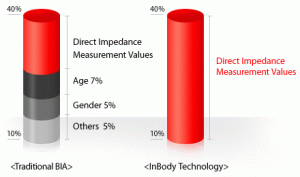It provides exact measurements and data analysis of an individual’s body composition including muscle mass, water, fat, protein, bone mineral and much, much more.
The technical term for this is Direct Segmental Multi-frequency Bioelectrical Impedance Analysis (DSM-BIA). It separately measures the impedance (resistance to alternating electric currents) of the trunk, arms, and legs of our body.
This new measurement concept measures the resistance of the cross point of two flows and takes the resistance values of the arms, legs and the body trunk.
This technology, developed by Biospace and patented worldwide makes a huge difference to the accuracy of your scan results.
Other equipment of lesser technology, measure the whole body as a single cylinder that measures one impedance value for your arms, legs, and trunk.


Controlling the path of high frequency waves is very difficult. This technical know-how is an InBody specific specialty and has been accumulated over many years of experience in the field.
Electric current has a different penetration force depending on frequency. Low frequencies travel down the flow of the external surface water and are unable to penetrate the cell wall, thus measuring the water content outside of the cell. A higher frequency will measure the water content inside of the cell because it penetrates the cell wall. By using a diverse set of frequencies, the InBody can accurately measure water contents inside and outside the cell separately.
When measuring impedance through any type of electrode, contact resistance occurs, and it is important to control the contact resistance in order to correctly measure the resistance in the body.
The InBody uses a unique method of electrode placement. The 8-point tactile method separates the current and voltage starting point, thus measurement always begins at a fixed point in the wrists and ankles. This provides high reproducibility and correct body impedance measurement because the contact resistance from the skin has been removed.


Empirical estimations are values that are achieved through gender, age and body type averages. This data is useful while measuring the typical body type. But what happens if you are not a typical body type? This is the case for the majority of people.
Due to the separate measurements of the trunk, arms and legs, your InBody results will be correct regardless of age, sex, race, and body type.